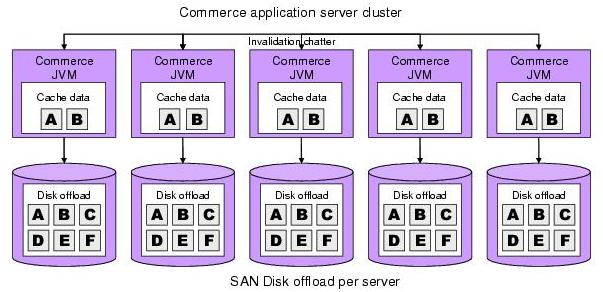6.2.2 Behavior: WebSphere Commerce with WXS
The integration between WebSphere Commerce and WebSphere eXtreme Scale does not require any change to applications using the dynamic cache API. But there are small changes to the behavior and the way the cache is managed.
The figure below shows a typical deployment of the default dynamic cache provider. Each appserver contains the same cached data that is replicated between the servers on a best-efforts basis.

The WAS dynamic cache service provides a variety of replication options.
- It can copy all data to every server, so all servers contain the same data. But that is expensive to do.
- It can publish invalidation events to every server, so that servers will not retain stale data. This is more efficient replication but means each server has to create their own cache entry.
Regardless of the sharing mode, as the site reaches a steady state, each Commerce server will contain the same cached data and every server will only contain a subset of the whole cache, with every server maintaining a disk off load of the cache. This is slower than an in-memory cache, but quicker than having to recreate the cache entry every time. However, for a large environment, that can be a significant disk requirement.
The figure below shows a remote topology deployment of the WXS dynamic cache provider. All data is placed in WXS and Commerce appservers have no responsibility for cache management. There is no cache replication traffic or disk off load. All cache accesses are over the network. The overhead of remote access is mitigated by compressing the content in the grid (around 2.5x or 3x) so that it is served efficiently. With WebSphere Commerce, portions of the cache (the data caches) are assumed to be local to the application and are therefore create a large amount of traffic.
We are going to highlight the main technical differences that will impact the design, configuration and management of a WebSphere Commerce deployment.
The architectural diagrams illustrate the benefits of moving to eXtreme Scale. Architectural differences highlights the main differences to consider specifically when moving the dynamic cache provider to eXtreme Scale.
